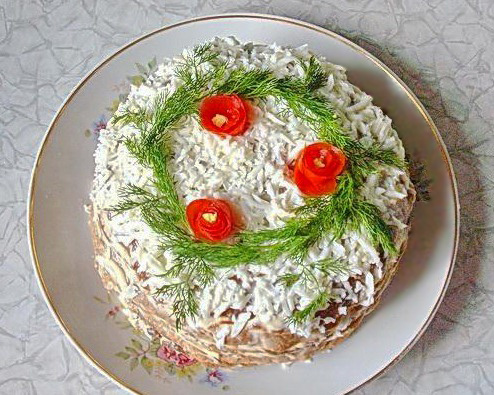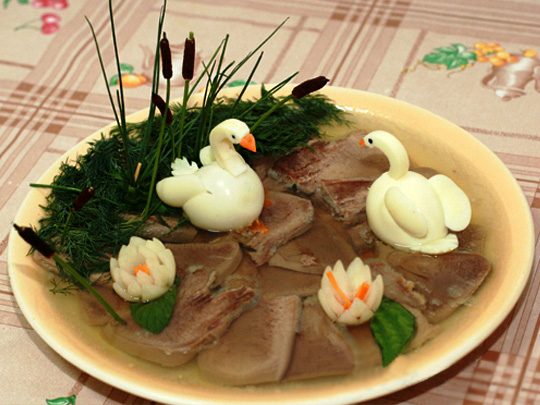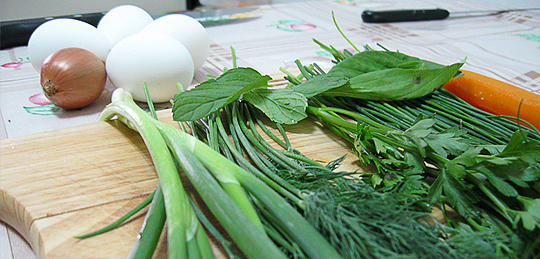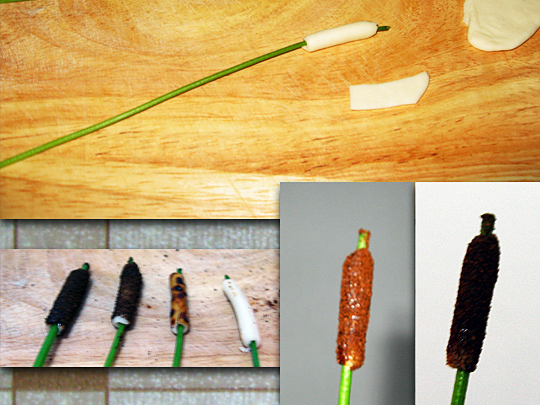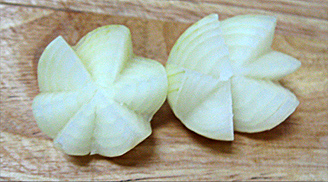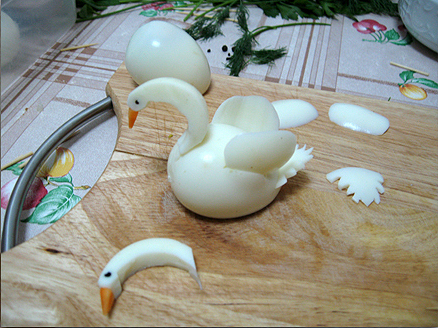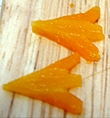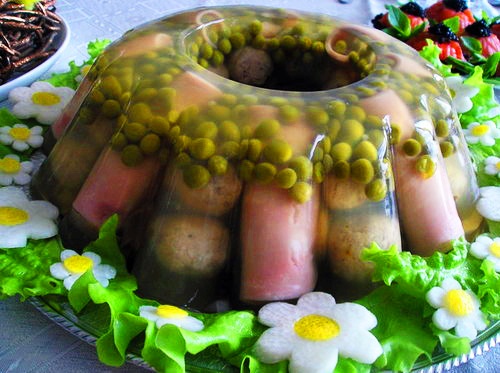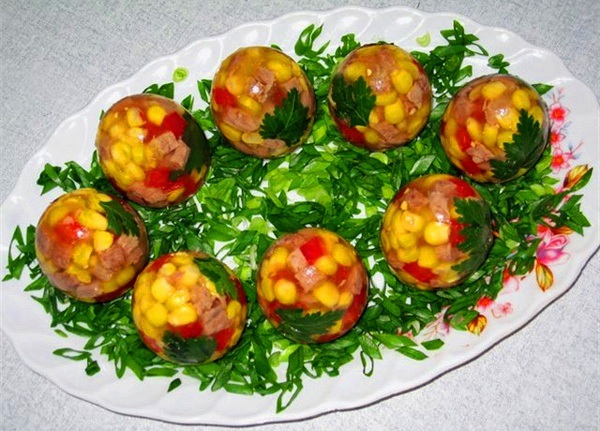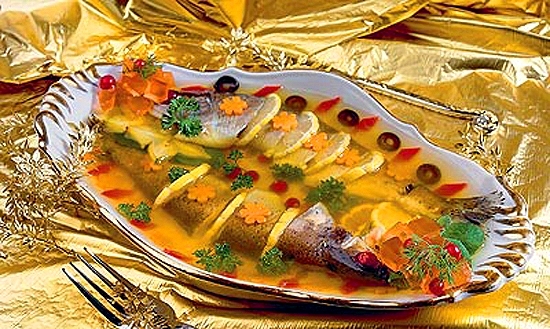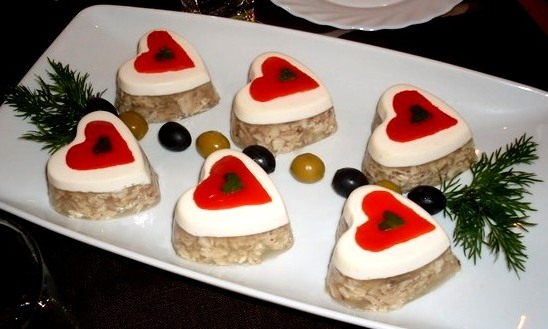Preparing complex cold appetizers. Technological process for preparing cold dishes and snacks. All of the above factors determine the relevance and significance of the topic of work at the present stage, aimed at a deep and comprehensive study
Send your good work in the knowledge base is simple. Use the form below
Students, graduate students, young scientists who use the knowledge base in their studies and work will be very grateful to you.
Posted on http://www.allbest.ru/
Introduction
dish snack technological
Food is the basis of human life. How a person eats affects his health, mood, and ability to work. Consequently, a person’s nutrition is not only his personal, but also a public matter. The French physiologist Brmat-Savarin owns the expression: “An animal is satisfied, a person eats, clever man knows how to eat." “Knowing how to eat” has nothing to do with satisfying hunger. The ability to eat presupposes reasonable, moderate and timely nutrition, that is, nutritional culture. And this very difficult science - nutrition culture? it is necessary to study, to learn from a young age, before a person has yet acquired diseases from excessive nutrition. So the kitchen is a very serious matter and requires respect.
Mass nutrition plays important role in the life of society. It most fully satisfies people's nutritional needs. Catering enterprises perform functions such as production, sale and organization of consumption of culinary products by the population in specially organized places, and some catering enterprises provide leisure services. Catering enterprises carry out independent economic activity and in this respect they are no different from other enterprises. Food for the population is provided mainly by small private enterprises.
Currently, activities in the field of mass nutrition are beginning, albeit slowly, to gain momentum. The first surge has already passed: many restaurants and cafes that opened at the beginning of the perestroika process have closed due to unprofitability and lack of competitiveness. However, the process gradually began. IN currently big cities Russia is experiencing a real restaurant boom: the number of hotels, restaurants, cafes, bars, and various clubs is rapidly growing. The mass catering industry is in the process of development - both the number of establishments and the quality of service are growing.
The network of food establishments used by the population is represented by various types: canteens, restaurants, cafes, snack bars, bars, etc. The need for organization various types determined by: the diversity of population demand for different kinds meals (breakfasts, lunches, dinners, intermediate meals, business lunches); the specifics of serving people both during short lunch breaks and during rest; the need to serve adults and children who are healthy and in need of therapeutic nutrition. The demand for mass catering products and services is constantly changing and growing.
All of the above factors determine the relevance and significance of the topic of work on modern stage aimed at deep and comprehensive study technological processes cooking, as well as design and presentation techniques for cold dishes and snacks and, of course, original ways their submissions.
1. History of cold dishes and snacks
In past centuries, the Russian people were distinguished by good health. Our national cuisine played not the least role in this. Thanks to its uniqueness and originality, it has long become popular in the world. What did our heroic ancestors eat and drink themselves and treat their guests?
Snacks are one of the features of Russian cuisine, which is distinguished by such a variety of cold and hot snack dishes, especially fish, which is not found in any foreign cuisine. Appetizers can be salads, vinaigrettes, pates, jellied dishes, jellies, boiled and fried meat, fish, poultry, game with spicy seasonings and sauces, all kinds of pickles and marinades, and other culinary products.
By developing our sense of hearing and satisfying its need for pleasure, humanity created music. Fine Arts appeared as a result of the need human eye in beauty. The senses of smell and taste are no less important than sight and hearing. To please them, the “kitchen” art of cooking arose. Flights of fancy and author's improvisation in culinary creativity are limited by only two conditions: healthy and tasty.
2. Classification of cold dishes and snacks
Cold dishes differ from appetizers in that they are usually served with a side dish and are more filling. Cold appetizers have a smaller yield; they are served either without a side dish (caviar, salmon, cheese, sausage) or with a very small amount of side dish (sprat, herring with onions). Cold appetizers are usually served at the beginning of a meal; they act as an appetite stimulant and complement the composition of the main courses. Recipes and methods for preparing cold appetizers are varied. Many of them have a spicy taste (herring appetizers, sprat), delicate taste(jellied fish, meat), in this case they are served with hot seasonings and sauces - mustard, horseradish, mayonnaise sauce to brighten the taste of the main snack and increase its nutritional value.
Especially big role cold appetizers are included in the banquet menu, where their number reaches 5-10 items. Snacks such as salads made from green onions, lettuce and fresh cucumbers are low in calories and are the main means of stimulating the appetite and a source of vitamins and essential micro- and macroelements. The recipe for many snacks includes vegetable oil or sauces and dressings for them. Such snacks are a source of unsaturated fatty acids, as well as vitamin E. It is of particular importance that vegetable oil in this case is not subjected to heat treatment and does not lose its biological activity. Some snacks are prepared from raw vegetables, fruits, and vitamins and other heat-unstable substances are well preserved in them. When preparing cold appetizers, mechanical processing of products is often carried out after heat treatment. This requires strict compliance with sanitary requirements for the preparation, storage and sale of cold snacks, equipment and maintenance of cold shops, therefore the sanitary standards and rules applied to employees of these shops are tightened and must be systematically monitored by the head of the enterprise.
The group of cold dishes and snacks includes: sandwiches, snacks from gastronomic products, salads and vinaigrettes, snacks from fish and non-fish seafood, meat, poultry, game, rabbit eggs, mushrooms. Much attention is paid to the design of cold appetizers.
To serve cold appetizers, special dishes are used: ceramic and metal dishes; herring fish; glass vases for fruits and raw tomatoes, cucumbers; ceramic vases for salads; caviar; single- or multi-serve salad bowls; sockets for lemon and herbs.
3. Tools and accessories for decorationcold dishes and snacks
On specialized enterprises that sell a small assortment of cold appetizers are given a separate workplace All in all production premises. Cold shops are designed for preparing, portioning and decorating cold dishes and snacks, sweet dishes and cold soups. Products used for preparing dishes are not subject to secondary heat treatment before release, so strict sanitary requirements must be observed in the workshop: products used for preparing dishes must be stored in refrigerated cabinets or chambers at a temperature not exceeding 6-8 degrees; utensils and equipment must be labeled and used for their intended purpose. In accordance with the technological process, workplaces for processing raw and cooked vegetables, gastronomic meat and fish products, portioning dishes, etc. must be clearly demarcated; salads, vinaigrettes, sandwiches should be prepared only in batches and sold within one hour; observe the temperature regime for storing and dispensing cold dishes (10-14? C).
The production program of the workshop (menu plan) includes the range and quality of manufactured dishes and snacks, sweet dishes and cold drinks.
To carry out the production program, workplaces are provided in the workshop, which are equipped with equipment, utensils and utensils, depending on the type of technological and production operations performed.
Let's consider the organization of workplaces.
At the workplace for slicing raw and cooked vegetables, the following is provided: a bath for washing fresh vegetables or a table with a built-in washing bath; industrial tables for slicing vegetables, cutting boards, chef's knives and functional containers. In the mass production of salads that are easy to prepare for complexes, the P-2 universal drive with interchangeable mechanisms for cutting raw and cooked vegetables and mixing salads is used. In addition, you can install the MROV-160 machine on the production table for slicing boiled vegetables. Chopping of vegetables is carried out by cooks of the 3rd category, and preparation of salads by cooks of the 4th category.
The second workplace is organized for preparing dishes from gastronomic meat and fish products. Products are cut on a cutting board using a medium chef's knife. Portioned pieces of products are placed in functional containers and placed in a refrigerator.
If a large number of dishes are prepared from gastronomic products, then it is advisable to use the MRG-300A machine for slicing ham, sausage, and cheese. It is installed on the table for small-scale mechanization SPM-1500.
The third workplace is provided for portioning and releasing dishes onto the dispensing line and is equipped with a production table with a refrigerated cabinet and a slide and a rack for placing ready-made dishes for sale. The slide is designed for storing pre-prepared products (canned fruit, parsley, lemons, etc.) used to decorate dishes, as well as for quick access to dressings, seasonings and spices.
In the summer, cold (vegetable, meat) and fruit soups are in great demand at catering establishments. For cold soups, vegetables and meat are cooked in a hot shop. After cooling, they are cut by hand into cubes or strips. Green onions are chopped manually using the UN3 device. The temperature for serving soups is 10-12? C.
In addition to chef's knives, there are a huge number of other devices and tools, the so-called equipment. This includes a variety of notches, carving knives, and knives with different blade shapes.
4. Technological process for preparing cold dishes and snacks
A large group of cold appetizers consists of potato salads and vinaigrettes.
A wide range of salads are prepared from boiled potatoes with the addition of raw, pickled, salted and boiled vegetables. The vinaigrettes include: boiled beets, carrots and potatoes, raw onion, sauerkraut or pickles. All these products are cut into slices or cubes and mixed. Dress potato salads and vinaigrettes with vegetable oil, vinegar, salt and pepper or vegetable oil dressings.
There are two technological schemes for preparing salads and vinaigrettes from boiled vegetables. In the first case, the vegetable processing process is structured as follows: washing, cooking, cooling, peeling, slicing, mixing components and gas station. In the second case - washing, peeling, rinsing, cutting, cooking, cooling, mixing the components and refueling.
According to the first scheme, potatoes and root vegetables are boiled in their skins, which are poorly permeable to mineral salts, sugars and water-soluble vitamins. This helps reduce their losses during heat treatment.
However, the traditional scheme for preparing salads from boiled vegetables has two significant drawbacks: the cleaning of boiled vegetables practically cannot be mechanized, and it is done manually, which leads to secondary microbial contamination. Therefore, the new technology has undeniable advantages, making it possible to mechanize the process of preparing vegetable salads for mass demand. At the same time, the loss of nutrients during heat treatment of chopped vegetables can be significantly reduced by replacing cooking in water with poaching or steaming.
For meat and meat products, boiled beef, tongue, ham, boiled pork, ham, fried and boiled poultry and game, and sausages are used to prepare cold appetizers. The ham is cleaned, bones are removed, the skin is removed, excess fat is cut off, and then cut into pieces convenient for slicing. Beef, pork, lamb, pre-fried in large pieces or boiled, free from the dried crust immediately before use. Before use, sausage (boiled, smoked) is wiped with a dry towel, the bindings are removed, the skin is cut and removed in the part intended for slicing. You should not remove the casing long before slicing the sausage, as this will cause the loaves to become dirty and quickly deteriorate. If the casing of the sausage is difficult to remove, then immerse the sausage in hot water for 1-2 minutes, wipe dry with a clean towel, cut and peel.
The cheeses are cut into large pieces (rectangular - lengthwise, round - into sectors), the outer rind is peeled off and cut into portioned pieces no more than 2 cm thick. The butter is peeled, cut into bars with a square or rectangular end, and then the bars are cut into portioned pieces in the form of a square or rectangle 0.5-1 cm thick. Products should be peeled and especially cut before serving and in the amount required for immediate implementation. The butter, cut into portions, is stored in cold water. To cut the butter into portions, use a gastronomic or carving knife.
Cold fish dishes are prepared from chilled boiled sturgeon fish links, fried and boiled portioned pieces various breeds fish (with skin without bones, without skin and bones - clean fillet), crayfish, squid, shrimp. Salmon, chum salmon, and salmon have their fins and heads cut off and then stripped. The resulting fillets with skin and rib bones are placed skin side down on a cutting board or table and the rib bones are cut off. The fish is cut, starting from the tail, into portioned pieces (at first with a large tilt of the knife - obliquely, and then almost straight), the flesh is cut to the skin and the pieces are separated from the skin without cutting through it. The rest of the fish next use cover with peeled skin. Balyks are cleaned of skin; if they come with a vertebral bone, then the fillet is cut off from the spine, the weathered and smoked parts are cleaned and cut crosswise into slices of 2-3 per serving. Smoked whitefish, cod, sea bass are skinned, the fillets are cut off and the rib bones are removed.
Smoked and dried fish of other species are peeled from the skin and cut into pieces along with the bones across. Large specimens can be cut along the vertebral bone into two layers, and then cut crosswise into portioned pieces. Herring is cut into fillets with bones or clean fillets.
Sprat, sprats, sardines, saury are removed from the jars, the head, tail and entrails of the sprat are removed. Sprats, sardines, and saury are served without additional processing. You can also serve sprat whole. After opening the canned food, carefully transfer it to a clean, dry container and portion it. Juice, sauce or oil is distributed evenly along with the main product.
To prepare cold dishes and snacks from vegetables and mushrooms, fresh, boiled, salted and pickled vegetables, mushrooms and herbs are used.
5. Basic rules for the design and presentation of cold dishes and snacks
The art of serving and decorating dishes is addressed, first of all, to the imagination of a person in order to create his mood and give the dish a special appeal. The ability to make a dish beautiful is one of the integral tasks of a technologist and cook. There are special rules, observing which in short time You can master the basic techniques of dish design, including cold dishes.
Products used
Both fresh and ready-to-eat vegetables are used to make various decorations. Some vegetables are not specially processed, since in this case they lose the qualities necessary for attractiveness.
For example, raw potatoes and turnips are ideal for creating white arrangements, while beets are ideal for creating red flowers. Lettuce, mint, herbs, leeks, cucumbers or Bell pepper will successfully serve as “leaves and stems” of a culinary bouquet. And lemons, oranges, watermelons, melons, avocados, as if by magic, turn into voluminous baskets, boats and boats.
The right combination
The main rule is that the dish and its decoration must complement and combine with each other. For example, potatoes in the form of mushrooms or flowers will ideally complement meat. A lemon rose will decorate seafood dishes. Color serves as the main means of creating and emphasizing the taste of food. When using dyes, you need to give preference to natural products: For coloring you can use saffron, paprika, curry, beet juice, mayonnaise, tomato paste. IN green color can be colored by adding chopped herbs.
Simple and tasteful
To achieve the greatest effect, a large amount of decoration is not required. Some dishes look much more attractive in their natural form, so you shouldn’t overload them with unnecessary decoration. To make jewelry look more impressive, you should resort to contrasting colors.
Green color is conveyed with the help of onions - leeks, cucumbers, various greens; orange - orange carrots; red - tomatoes, beets; white - hard-boiled egg, fresh turnip. For the rest, trust your imagination.
Location
It is necessary to carefully consider the location of all decorative elements in advance. The dishes should not distract attention from the dish itself. Remember that any decorated dish will arouse more interest than its “modest neighbor”. Decorations should be neat, cut lines should be clear and concise. The edges of the plate should be wiped clean before serving.
Meat, fish and poultry dishes can be lightly brushed with vegetable oil just before serving - this will give the fried crust a special appetizing shine.
If short-term storage of jewelry is necessary, it can be stored for 1 hour under certain conditions that do not allow natural products to deteriorate. Potatoes or turnips should be stored in the water in which they were boiled in the refrigerator. It is better to place the beet decorations in wine vinegar.
6. Assortment of dishes with the most original designmand design elements
Tomato bird
Vegetable salad or any other dish can be decorated with original small red-breasted tomato birds.
To prepare them you will need: tomatoes, olive (or dark blue grape), turnip, egg white, toothpicks.
1. Cut off the base of the tomato.
2. Using a toothpick, attach a dark blue grape or olive to the tomato - it will serve as the “head” of the bird.
3. Cut out the “tail” and “wings” from the turnip and insert them into the slits on the tomato.
4. Make eyes from the white of a hard-boiled egg.
Bee hive
On the table with cold appetizers, a hive of butter bees will undoubtedly delight your guests.
The best place for it is a tray with cheeses or sausages. It can be used as a table decoration at breakfast.
To prepare a chic hive you will need: butter, almonds, olives, juniper berries, chocolate, a pastry bag, thin slices of toasted almonds.
1. Roll a stick of softened butter into a cone and use a fork to make grooves in it.
2. Cut the almonds in half (for the bee body). Apply stripes of melted chocolate to each half.
3. Secure the body of each bee onto the hive by gently pressing it into the butter.
4. Stick in thin slices of almonds as wings. Make antennae from olives cut into strips, and a head from juniper berries.
Butter rose
To make rose from butter you will need: 250 g butter.
1. Cut a corner from a stick of butter and roll it into a small cone in your hands.
2. From the remaining stick of butter, cut a semicircle on one side with a knife, and then another on the other, so that you get a cylinder with one truncated side.
3. Using a sharp knife, cut it into thin slices.
4. Use your hands to form a flower petal out of a stick of butter.
5. Secure the first petal, as if pressing it to the base of the cone.
6. Attach the remaining petals and place the rose in the refrigerator.
7. Make leaves from the remaining slices of butter and draw veins on them using a sharp knife.
Roasted Potato Roses
If you would like to create a "bouquet of white or yellow roses", then use potatoes or turnips as the main product. “Red roses” will be made from beets or from potatoes colored with beet juice. If you have chosen potatoes, then it is advisable to take potatoes that are not young (but elastic) - slices from young potatoes turn out to be quite fragile.
1. Cut the “petals” of the future “rose” 1-1.5 mm thick from raw potatoes on a special grater for vegetables. If you do not have such a grater, then cut into slices sharp knife as thin as possible. Try to ensure that the “petals” are not only thin, but also uniform in thickness. The result should be very thin, almost transparent potato circles.
2. To make the basis for the future rose - a “bud”, cut one potato plate thicker (about 3-4 mm) in order to cut it into long sticks. You will wind the “petals” around these blocks. Let's start making roses. Take the central “bud” and wrap one petal tightly around it. Then take the other petal and twist it the other way. After this, secure the bud with a piece of a thin toothpick.
3. After this, wrap the other petals, moving them slightly from above, so that the “rose” turns out to be “blooming”. Strictly follow the rule: one petal - clockwise, and the next - counterclockwise. The larger you want to make the “rose,” the more petals and toothpicks to hold them together. Then lightly shake off the water and dry the “roses” on a napkin. While the roses are drying, place a small cauldron with vegetable oil on the fire and heat it to the desired temperature. To check if the oil is hot enough, take one petal, dry it with a napkin and place it in the oil. If it sizzles happily and bubbles appear, then the oil is ready for frying, but if it sizzles weakly, then you need to wait a little longer.
4. Place the rose head down in the hot oil, being careful not to let it tilt to one side for 1-2 minutes. At this time all the petals will open. Now carefully turn it over and fry on all sides until golden brown. When the “rose” acquires a crispy color, it is ready. Remove it from the cauldron onto a paper napkin to allow excess oil to drain. Sprinkle lightly with salt. When the roses have cooled slightly, remove the toothpicks. It is easier to pull them out if you turn them a little around the longitudinal axis before pulling them out. When the finished “roses” have already fallen apart, you can carefully transfer them to a plate. Place the “roses” on the lettuce leaves.
Romantic bouquet
To make this composition you will need: radishes, olives, leeks.
1. Take small radish heads, rinse them thoroughly and cut into thin, translucent circles (it is better to use a peeler for this).
2. Place radish circles in the shape of flowers on a piece of meat, pate or cold meat.
3. The core of the flower will be a piece of olive.
4. Make “stems” from the leeks. And cut out “leaves” from the thicker part of the onion.
Pine cone
5. Complete the composition with a sprig of parsley and a small bouquet of tulips made from radishes and watercress.
This decoration is suitable for a wide variety of meat or vegetable dishes.
Collected in groups of three or five and placed with toothpicks among the leaves of watercress, the cones form quite spectacular “bouquets”.
To prepare such incredibly beautiful “cones” you will need: carrots, watercress, toothpicks.
1. Cut a cylinder out of a carrot and round the edges at the base.
2. Using a sharp knife, make an arc-shaped cut at the base of the cylinder.
3. Use a knife to remove the thin layer of carrot pulp behind it.
4. Moving up, continue to cut out longer scales of the pine cone, placing them in a checkerboard pattern.
5. Finish the pine cone with three small scales, removing the pulp between them.
"Happy Star"
Such stars can be made from both oranges and lemons. This decoration is used for dishes such as duck with oranges or fruit salad.
To prepare this decoration you will need: orange or lemon.
1. Cut a lemon or orange into slices and remove a thin layer of zest from one of the slices to the white outer layer.
2. Cut the slice with a knife along the contour of the slices - from the edge to the center.
3. Carefully turn out the small triangles that will become the rays of the star.
4. Place the slice completely inside out on a plate. The star's rays should be directed outward.
5. Insert a hexagon-cut slice into the center and line it up with your fingers.
Boiled egg decorations
These decorations perfectly complement the dish and do not require much expense.
With their help, you will quickly and successfully decorate dishes prepared not only for festive dinners and special receptions.
To make these decorations you will need boiled eggs.
1. Cut the hard-boiled egg into slices or slices and arrange them in the form of a chamomile or rosette.
2. Place the olive halves on the yolk.
Fruit hedge
A fruit fence can be used to decorate both cold and hot dishes with oranges (baked duck, pate). Lemons can also be used for this purpose.
To prepare this fence you will need:
1 hard orange, carving knife.
1. Make longitudinal grooves in the peel along the entire circumference of the orange.
2. Cut it in half along the grooves.
3. Cut off the ends of both halves.
4. Cut each half into slices of equal thickness, being careful not to separate them from each other.
5. Make an upward motion with your right hand and move the slices slightly. Place the “hedge” on a platter.
Green onion flower
The core and petals of the “flower” are made from wide parts of leeks and held together with toothpicks.
A wonderful decoration for any savory dish.
1. Fold a wide leaf of leek in half lengthwise and make frequent cuts on the fold side, as shown in the photo.
2. Roll it up - this will be the core of the flower.
3. Make petals from the wide parts of the onion.
Lotus flower
Cold dishes will look original and beautiful if you decorate them with an onion flower like this.
To make this flower you will need: onions, a knife, water and lemon juice, food coloring.
1. Cut the peeled onion in half.
2. Cut out the petals in a checkerboard pattern.
3. Place the onion in cold water mixed with lemon juice for 2 hours.
4. Color the edges of the petals with food coloring.
5. Place the flower on a plate, and place bay leaves under it in a circle.
Orange bowl
This orange bowl can be used to place a bouquet of flowers cut from vegetables or serve a fruit salad in it.
You will need: a large round and smooth orange, toothpicks, a citrus juicer.
1. Make indentations in the peel of a smooth orange, trim it on both sides and cut it into two unequal parts (1/4 and 3/4).
2. Using a citrus juicer, remove most of the pulp from the orange.
3. Using a toothpick, secure the “stand” to the “bowl”.
4. Place a bouquet or put a fruit salad in a basket.
Jellied eggs
Empty eggshells from 8 eggs, gelatin (instant) - 20g, vegetable or fish broth - 200g (also for cooking vegetable broth: onion, carrots, salt, allspice), quail eggs - 6-8 pcs., shrimp ( boiled-frozen) - 100-150 g, canned corn - 85 g, parsley and dill
For this dish, first of all you will need an empty eggshell - it is better to prepare it in advance. Wash the eggs and wipe dry. Make a small hole at the blunt end of the egg using a knife and widen the hole to 1.5-2 cm. Pour out the contents of the eggs (white and yolk) and use them for preparing other dishes - they will not be needed in this recipe. Empty eggshells rinse well in a soap-soda solution and rinse thoroughly with running water. For convenience, place the prepared, washed and dried eggshells in an egg mold. Cook vegetable broth. Pour water into a saucepan, add peeled whole onions and carrots, bring to a boil, add salt, add a couple of allspice peas, reduce heat and cook for 20 minutes until tender. Then place 1 sprig of greens on the bottom of the empty egg, a few pieces of all the ingredients and carefully pour broth with gelatin to the top. Place in the refrigerator overnight. Before serving, carefully remove the shells from the eggs. Place on a plate.
7. Quality requirements, storage conditions and periods
Requirements for the quality of cold dishes and snacks are similar within different groups.
I) Sandwiches
1. open
A. with boiled sausage, with smoked and semi-smoked sausage, with ham, with lard, loin, brisket, with butter, with cheese, with caviar, with sturgeon fish, with fish gastronomy, with jam or jam:
All types, except for a sandwich with bacon, are prepared on wheat bread (with bacon, loin, brisket - on rye bread)
YU appearance: a thin piece of bread covered with 1-2 thin even pieces of the selected product (gastronomy, fish, meat cut diagonally)
The color, taste, and smell are characteristic of the selected product; there are no foreign tastes or odors.
2. combined
A. with pate
Yu is cooked on wheat bread
Appearance: the bread is covered with a piece of pate, with a slice of boiled egg on top
The taste and color are characteristic of meat or liver pate
b. with meat products and vegetable salad
Yu on rye or wheat bread
Appearance: a piece of bread is covered with a vegetable salad; thinly sliced and rolled fried beef, pork or lamb is placed on top. The sandwich is decorated with butter mixed with mustard and fresh or pickled cucumbers.
Yu color: meat products - light brown or gray, vegetables - natural color.
Yu taste is slightly spicy
V. with vegetable salad and fish
Yu used wheat or Rye bread
Appearance: bread is covered with vegetable salad, a piece of boiled or stuffed fish is placed on top. The fish is decorated with thick mayonnaise and herbs
Yu color light cream
Yu taste, characteristic of vegetable salad and fish
3. closed (sandwiches)
A. appearance: bread is covered with a thin layer of butter or mayonnaise, on top are thin slices of meat or cheese or fish, covered with strips of bread 0.5-0.7 cm thick. Consist of 2, 3 layers of alternating components
b. color, taste: correspond to the products used
4. snack bars (canapés). Small curly sandwiches that are beautifully decorated and served as a snack. For decoration, butter, oil mixtures, and mayonnaise are used. They release 3-5 pieces. per serving weighing 80g.
A. They use wheat, rarely rye bread. The crusts are cut off from the bread and cut into strips 0.5 cm thick, 5-6 cm wide, or cut into strips. Sliced bread is dried in an oven or toaster and cooled
b. appearance: has a beautifully designed pattern, complete character, curly shape
V. color and taste correspond to the products used
II) Fish cold dishes and snacks
1. balyk, salmon, lightly salted; smoked stellate sturgeon, beluga; sturgeon, stellate sturgeon, beluga boiled with horseradish
A. the fish is cleaned of bones and skin, cut into wide or narrow pieces. Lightly salted fish is decorated with lemon and herbs; smoked served with vegetable side dish and horseradish sauce; served with fresh tomatoes or cucumbers and herbs, horseradish sauce served separately; boiled fish served with a side dish of gherkins, red cabbage, pickles and fresh tomatoes;
Taste, color, smell are characteristic of the products used
2. jellied fish
A. They use boiled sturgeon and particulate fish. Sturgeon fish is cut into pieces from the link, without cartilage and skin, fish of the partial breed is filleted with skin and boiled. Pieces of fish are decorated with boiled carrots, slices of fresh cucumbers, herbs and filled with transparent fish jelly.
Yu appearance: the surface of the fish pieces should have a well-cooled jelly layer of 0.5-0.7 cm, the edges of the jelly are corrugated
Yu color characteristic this species fish, light yellow jelly, transparent
Yu taste and smell characteristic of boiled fish; jelly with the aroma of spicy herbs, onions and spices.
Yu consistency: the fish is soft, but not overcooked, the jelly is elastic
3. stuffed fish
A. For stuffing they use pike perch, pike, cod, carp, carp, and bream. The fish carcass is stuffed with minced fish and poached.
Yu appearance: the natural shape of a fish of the appropriate breed, decorated with a garnish of vegetables, herbs and lemon.
Yu color: fish of the corresponding breed - light yellow or light gray)
Taste and smell characteristic of boiled fish, with the aroma of spicy herbs, onions and spices
The consistency of the fish is soft, but not boiled
III) Cold meat dishes and snacks
1. veal or jellied tongue
A. It is prepared in the same way as fish jelly. Garnished with a side dish of red cabbage salad, green salad, green peas and chopped fresh cucumbers and tomatoes. Horseradish sauce with vinegar is served separately.
Appearance: transparent jelly, decorations of vegetables and herbs on the surface, smooth glossy surface
Yu color: jelly - dark golden, meat - dark gray
The taste and smell of boiled meat and jelly
2. liver pate
A. appearance: loaf or rectangle shape, surface decorated with a pattern of butter and eggs
b. taste and smell of liver pate
V. consistency is homogeneous
d. the color of the pate on the cut is grayish-brown, on the surface of the eggs and butter
The quality requirements for other dishes from the group of cold dishes and appetizers are similar.
Cold dishes and snacks, as well as food items for them, are stored in refrigerated cabinets at a temperature of 0-6? C in porcelain or enamel containers (without cracks or chipped enamel), with the lid closed. Roast beef, ham, poultry, game are stored on dishes or baking sheets, and balyk salmon, sturgeon and similar products are stored on marked dry boards under dry gauze; the products are cut before serving.
Cold meat and fish dishes with side dishes, as well as seasoned with sauces, can be stored for no more than 30 minutes. Sandwiches can only be stored as snack bars coated with jelly, but not for more than 12 hours.
Prepared products for decorating salads can be stored in the cold for no more than 1-2 hours. The maximum shelf life of dressed salads from boiled vegetables is 30 minutes, from raw ones - 15 minutes.
Products in opened cans are stored for no more than 3 hours, and in porcelain, glass or enamel containers - no more than a day. Jellied, jellied fish, fish with mayonnaise, marinade, stuffed peppers, zucchini, eggplant, as well as caviar from them and mushrooms are stored for 24 hours.
Conclusion
Public catering as a branch of the national economy is a set of enterprises united by the nature of the processed raw materials and products, the organization of production and the form of service to the population. Public catering performs three interrelated functions: production finished products, its implementation and organization of consumption. The activities of public catering enterprises in the process of performing these three functions are characterized by a number of features that bring them closer to enterprises Food Industry and retail trade.
Among mass catering enterprises, the main place is occupied by restaurants, cafes, and bars. They play a significant role in organizing recreation for the population. People come there not only to eat, but also to celebrate their anniversary, an important event in the life of a person, of this or that team, to hold a wedding celebration, business or official meeting, or simply relax with loved ones.
To warmly welcome people, quickly and deliciously feed them, to create all the conditions for them to have a good rest - this is the task of the workers of these enterprises.
Public catering establishments located in hotels, airports, railway stations, and ships occupy leading place in organizing catering for tourists, including foreign ones. Autotourism is becoming widespread - traveling by bus or car with stops at campsites, during which tourists eat in restaurants, cafes, and bars.
The number of people who are becoming financially secure and are able to spend a certain amount of money on spending their leisure time outside the home is constantly growing.
The mood and well-being of everyone who uses their services depends on the correct and precise organization of the work of the service personnel of mass catering enterprises.
IN modern conditions a deep and comprehensive study of the state of mass catering enterprises becomes relevant. The main objectives of public catering enterprises are to most fully satisfy the needs of the population, improve the quality of products, and improve the culture of service.
Bibliography
1. Anfimova N.A., Tatarskaya L.L. Cooking. - M.: Education, 2002.
2. Bordunov V.V. Commodity Science, 1987
3. Vukolova M.V. Cold shop of a catering establishment. - M.: Publishing house Ros. econ. Acad., 1995.
4. Ermakova V.I. Cooking. - M.: Education, 1993.
5. Ershok A.N., Yurchenko A.F. Technological equipment for public catering establishments. - M., Economics, 1991.
6. Zolin V.P. Technological equipment for public catering establishments. - M., Education, 1999.
7. Ivanova A.V. Cold food holiday. - M., Culinary, 2001.
8. Matyukhin Z.P. Fundamentals of nutrition, hygiene and physiology. - M.: Education, 1999.
9. Nikulenkova T.T., Margelov V.N. Design of catering establishments. - M., Economics, 1999.
10. Network resource http://www.magic-cook.com/
11. Network resource http://edimka.ru/cgi-bin/gen.pl
12. Network resource http://u-samovara.ru/
Posted on Allbest.ru
Similar documents
The concept and structure of a cold table, its components and meaning in Russian folk cuisine. Classification and types of cold dishes and snacks, preparation of products and requirements for them. Production technology and paint palette, principles and rules of design.
presentation, added 04/07/2015
Preparation of products included in the assortment. Heat treatment of meat and fish for preparing salads. Cooking technology, presentation, quality requirements. Organization of the workplace when preparing cold dishes and snacks.
abstract, added 10/09/2012
Comparative analysis an assortment of cold dishes and snacks of European cuisine in restaurants in the city of Omsk. Justification of recommendations for updating the restaurant menu. Development technological maps signature dishes and snacks for the purpose of introducing them into the menu of the enterprise.
course work, added 01/30/2015
Molecular gastronomy techniques. Analysis of the assortment of cold dishes and snacks sold in Moscow restaurants. Features of preparing cold dishes in molecular cuisine. Experimental development of culinary products. Calculation nutritional value ready meals.
thesis, added 12/05/2014
Studying the elements of the cafe menu: specialties, cold dishes, appetizers, soups, main hot, sweet, flour dishes, drinks. Review of technological features of cooking. Quality requirements, shelf life and sales, design and presentation.
course work, added 08/29/2012
Assortment of cold dishes and snacks. Rules of molecular technology for their preparation, taking into account the flow of technical processes. Experimental development of new culinary products. Calculation of nutritional value of ready meals. Development of technical and technological maps.
course work, added 02/12/2015
List of services provided by the restaurant "Shafran". Technological process for preparing branded cold desserts. Organization of the work of a cold shop designed for portioning and decorating cold dishes and snacks, sweet dishes and soups.
practice report, added 02/25/2015
The importance of cold dishes and snacks in nutrition. Requirements for the quality and presentation of ready-made dishes. Technology for preparing salads from boiled vegetables, complex cold dishes from fish and seafood, from farm (poultry) poultry, game and rabbit.
practice report, added 10/15/2014
Historical reference about the origin of vegetables, methods of their mechanical processing. Making decorations from vegetables, using them to decorate cold dishes and snacks. Changes in vitamins, minerals and carbohydrates during heat treatment.
course work, added 12/13/2013
Serving cold dishes and snacks. Arrangement of snacks on the table and plan for their location. Serving hot snacks. A dish for serving boiled crayfish, shrimp and crabs. Methods of serving soups. Temperature for serving second courses in canteens, snack bars and restaurants.
In nutrition, good presentation of dishes is very important. The more attractive the appearance of a dish, the greater the appetite it causes and the better it is absorbed by the human body.
Arrangement of cold dishes and snacks
Cold dishes and snacks are served beautifully decorated in salad bowls, porcelain dishes, vases or small plates.Salads and vinaigrettes are placed in a heap in a salad bowl and decorated with parsley, egg slices, green peas, finely chopped green onions and dill.
For decoration, you can also use all the boiled vegetables included in these dishes. Stars, flowers, and various figures are cut out of boiled beets, carrots, and turnips and placed symmetrically along the edges of the dish.
Decorations stand out more sharply if you first pour sour cream or mayonnaise over the salad.
In winter, they serve it as a special snack. sauerkraut and pickles. The cabbage is placed in a heap in the middle of the plate and decorated with cucumbers cut lengthwise.
Cold meat snacks must be cut evenly and neatly. The sausage is cut diagonally so that the slices are large.
Smoked sausage is cut into thin translucent slices, and boiled meat and boiled sausage- thicker so that they do not crumble.
The jelly is served out of the mold, after removing the fat from it.
Meat products placed on a dish or plate are garnished with fresh cucumbers and tomatoes, red or white cabbage, etc.
The side dish fits beautifully around the appetizer without covering it.
Herring and various fish snacks are served on special fish trays. The herring is cut into small slices and placed in the form of a whole fish.
Chopped herring and fish pate are also placed. Decorate with onions and green onions, various vegetables.
Before serving, canned fish must be taken out of the jar onto a plate or dish and also garnished with herbs.
The bread should be sliced thinly. It is not recommended to place on one plate a large number of sliced bread, it is better to spread it a little on two plates.
If both white and rye bread are served together, then several slices of white and rye bread are placed on the same plate.
Decoration of soups
Soups, in addition to good taste, should also have an attractive appearance. This is facilitated by even and beautiful cutting of vegetables and meat.The soup served must be at the required temperature. For hot soups - no lower than 65°, for cold soups - no higher than 10° C.
Before serving, soups are sprinkled with finely chopped parsley or green onions.
The soup is served poured into deep plates, which are placed on large small plates.
The soup can be poured directly at the table from a special porcelain or earthenware soup bowl. In this case, sour cream and chopped herbs are served separately.
Decoration of second courses
For second courses, it is important to choose a side dish. It must match the taste of the dish and complement it successfully. Side dishes should be constantly varied.Garnish for cutlets, fried meat, boiled sausages, sausages are various fried, boiled, stewed vegetables, mashed potatoes, boiled pasta, crumbly porridge.
TO fried chicken It’s good to serve boiled rice, with goose - stewed cabbage or baked Antonov apples, for the duck - new potatoes.
TO fried fish and fish cutlets are served with boiled or fried potatoes, green peas, and boiled carrots.
Usually the prepared dish (cutlets, meat, fish) is placed on the plate on the left, and a side dish is placed on the right.
The side dish is placed in the middle of the plate, then cutlets, meat or fish are placed on top of it.
Sausages with mashed potatoes can, for example, be decorated like this: put mashed potatoes slightly diagonally in the middle of an oval dish or small plate, level it with a tablespoon, giving the potatoes the appearance of a beautiful oval mound, and use a spoon to make several indentations in the mound.
Place one sausage on one and the other side of the slide, and the third one at the top of the slide and pour over the previously melted butter.
You can also put sausages on the left side of the side dish.
The side dish can also be complex, that is, consisting of several elements (for example, stewed cabbage, fried potatoes, boiled carrots). In this case, it is placed symmetrically near the main dish, in “bouquets” of the same size. Before serving, the dish is topped with sauce, juice or melted butter.
For some dishes (vegetable cutlets, casseroles, pancakes and cheesecakes), the sauce should be served separately or poured on the side of the plate.
All dishes should be supplemented with as much greenery as possible: chopped parsley, finely chopped green onions, dill, etc.
Fresh cucumbers, tomatoes, and radishes are recommended as additions to second courses.
Decoration of sweet dishes
The decoration of sweet dishes should also be given great attention.Compotes should be well chilled, have clear syrup and uncooked fruit, jelly should have the appropriate thickness and color, and also be chilled.
Fruit and berry jelly - transparent, sour-sweet taste, with the aroma of the fruits used for its preparation.
Jelly is sometimes made from fresh or canned fruits, which are placed in molds and filled with a clear mixture prepared for hardening.
Ice cream and ice cream should be taken out of the mold with a special spoon moistened with hot water; Some types of ice cream are decorated with canned fruits and berries, jam, and whipped cream.
Popular recipes on our site
|
- 700 g beef liver
- 3 eggs
- 60 ml milk
- 100 g flour
- 200 g onion
- 200 g carrots
- 3 cloves of garlic
- mayonnaise or thick sour cream
- vegetable oil for frying
- salt, seasonings to taste
For decoration:
- 3 boiled eggs
- tomatoes
- greens, etc. to taste and imagination
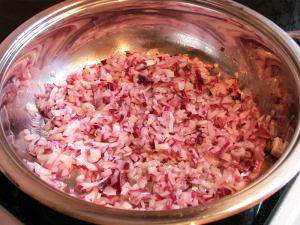 |
Finely chop the onion with a knife. Grate the carrots on a medium grater. |
|
 |
Add grated carrots to the onion and fry well. |
|
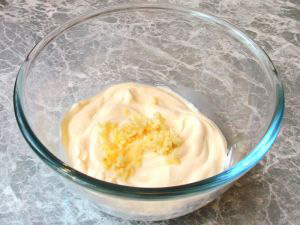 |
DECORATION OPTION 3
Grease the top of the cake with mayonnaise and sprinkle grated egg whites on top. Decorate with sprigs of greenery and... Different variants for design and decoration, see page. OPTIONS FOR PREPARING THE BASE OF LIVER OR MEAT OR FISH SNACK CAKE Cut 700 g of liver into pieces and fry in oil. Or you can take boiled meat - beef, pork, chicken, turkey. Separately fry the chopped onion(can be added with finely chopped carrots). Hard boil 3-4 eggs. This method of decoration is suitable for any aspic, be it fish, jellied meat...
Reeds. We take the strongest dill stalks and at the end of thick dough we stick knobs in the shape of reeds. Then the dough must be slightly moistened so that the instant (or ground) coffee sticks. Roll the dough in ground (or instant) coffee and the reed is ready - it turns out very realistic.
Lilies. We cut a small onion head in the shape of a basket and rotate each inner layer 30 degrees to give the shape of a flower, insert thinly sliced carrots inside, and the stamens are ready.
Swans. We cut off the layer of 2 eggs obliquely, closer to the thin part, giving stability to the shape of the body. We cut out the cut part in the shape of a tail, as in the photograph (if your imagination allows and you have time, then go ahead and experiment in inventing your own methods). Cut out the necks and wings from the remaining two eggs. We cut out a “beak” from a carrot, which we place on a toothpick. The smallest peppercorns will be the “eyes”. Before inserting the “eyes”, you need to drill through the white with the blunt end of a toothpick. We do this with all the holes in the entire “structure”. You need to be careful with egg whites, because... it is very fragile and breaks easily. We string the neck onto a toothpick and insert the other end into the body at an angle. We cut out 3 pockets on the body - 2 along parallel to each other, and one across for the tail. We put everything in its place. We cut out “legs” from carrots.
We use dill to imitate the shore and grass. Insert young garlic and “reeds” into the frozen aspic. If they do not hold, we pierce holes in the meat with a toothpick and insert “reeds” into them.
We put everything in its place (see photo in the title) - and the dish is ready. Prepare jellied meat (jelly) or aspic according to your favorite recipe (see section “Russian Cuisine” page).
Wash raw eggs thoroughly, cut off the tops, pour out the contents and use them for various dishes. About decoration easter eggs see in the section RUSSIAN CUISINE page and in the section RUSSIAN ORTHODOX CUISINE page. Chicken aspic, cooked in shaped molds, topped with a layer of mayonnaise with gelatin, a large “heart” of sweet red pepper, a small green “heart” of cucumber peel. |

